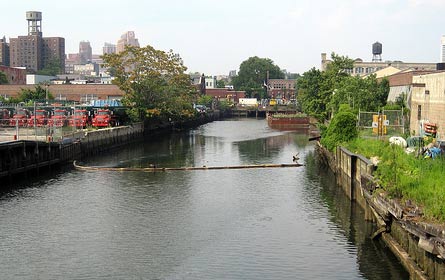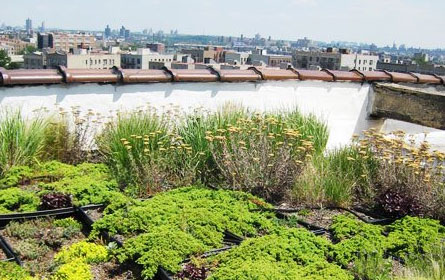Targeted Cuts, Improved Productivity Could Save City Services
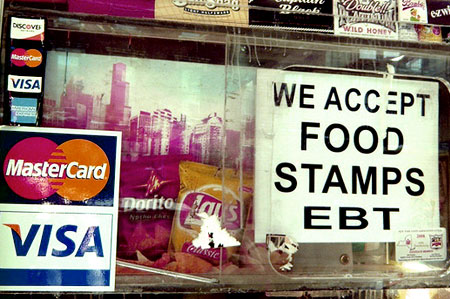
Photo (cc) clementine gaillot
In the short term, New York City’s budget prospects for fiscal year 2011 are much brighter than they seemed last summer. A review of recent reports from city and state fiscal monitors confirms this. At the same time, social and economic prospects remain bleak, both in the short and long term.
A review of recent reports from city and state fiscal monitors confirms both the rosier fiscal outlook and the grim consequences of the national recession. In this context, Mayor Michael Bloomberg’s recent budget strategy -- successive waves of across-the-board cuts in agency spending -- looks more and more unresponsive to the realities of life in the city today.
The administration quietly requested the next round of cuts in a memo to city agency heads in November, and the reductions are likely to be formalized in January's preliminary budget for fiscal year 2011. So now is a good time for the mayor, the City Council and advocates to look at alternative fiscal strategies, such as targeted budget cuts, progressive revenue options and city management practices. The City Comptroller’s November Comprehensive Annual Financial Report for FY 2009, for instance, underscores the city's short-term fiscal soundness, yet raises several questions about how the city is managing its programs, especially contracted services.
The City’s Fiscal Condition
Thanks to huge Wall Street profits -- nearly $50 billion in the first three quarters of calendar 2009 -- city tax revenues in the current fiscal year, as noted in the mayor’s cryptic November budget modification, are nearly $700 million higher than anticipated. For instance, the estimate of personal income tax revenues jumped by nearly $300 million to $6.3 billion.
December reports suggest tax revenues will be even higher than that this year and in 2011-2013 as well. The Independent Budget Office's December Fiscal Outlook, for example, projects revenues will be nearly $400 million higher this year and $958 million higher in 2011 than the mayor’s November estimates.
Overall revenue has grown in spite of the extreme volatility in several major taxes. The State Financial Control Board’s December report on the same modification reviews the rapid changes in three of the city’s major taxes: the bank tax and the two property transaction taxes (mortgage recording and property transfer taxes).
The bank tax, for instance, peaked at $1.2 billion in revenues in 2007, fell by 48 percent in 2008, then bounced back in 2009 with a 75 percent spurt, yet is projected to fall back to $674 million in 2010. The two property transaction taxes peaked in 2007 at a total of $3.3 billion. Revenues then began heading down and are projected to this year to a (relatively speaking) mere $1 billion.
In spite of these fluctuations, the comptroller’s November report points out the basic soundness of the city’s finances. The 2009 budget year marked the 29th year in a row that the city ended its fiscal year with a balanced budget. The city’s credit ratings remain solid and, for the fifth consecutive year, the city did not have to issue short-term notes to manage cash flow. And, although the fiscal monitors worry about long-term budget gaps (the state comptroller’s December report on the November modification projects a worst-case scenario of a $7.6 billion budget gap in 2012), there seems to be no alarm about the short term.
The Great Divide
The way the city balances the budget is another matter. The current economic and social news is terrible. While job losses in the city are now projected to peak at 220,000 this calendar year -- 108,000 job fewer losses than projected last June -- the reality is that the city’s unemployment rate almost doubled between July 2008 and September 2009, from 5.4 percent to 10.3 percent.
The state comptroller’s report lists several consequences of the recession that the mayor and City Council will need to deal with in the 2011 budget. Between October 2008 and October 2009:
* Medicaid recipients increased by 7.4 percent, to 2,809,642.
* The number of families in shelters increased by 8 percent to 10,396.
* Public assistance recipients increased by 4 percent to 355,459
* Food stamp recipients increased by 22 percent to 1.6 million.
The social/economic contrasts in New York City could not be more stark: On one hand, a relative handful of financial firms -- and their most fortunate employees -- enjoy $50 billion of profits; on the other hand, one third of New York city residents now qualify for Medicaid, a clear sign of the depth of need in the city at the moment.
The Budget Cuts
Yet at this critical time, the mayor has continued to focus almost exclusively on cutting agencies across the board, including the city’s extensive network of health and social services -- most of them run by contracted non-profit community agencies with little political clout.
The Financial Control Board's December report lays out the agency impacts of the mayor’s basic budget-gap strategy from January 2008 through the June 2009 Adopted Budget. The cumulative impact of the cuts -- or "savings" as the report calls them -- is just under $3 billion this fiscal year. Anticipated savings in the next three years average $3.36 billion a year. Projected cuts in health and welfare agencies alone average $422 million a year from 2010 through 2013.
The nearly $3 billion in savings this year is actually $776 million less than what was originally proposed. This is due to budget restorations, a hopeful sign that the City Council and others have pushed back on some of the mayor’s proposed cuts. (The outer-year savings assume $202 million in restorations each year.)
The $3 billion, however, does not include cuts proposed by the mayor in his November memo to agency heads: an additional $550 million this fiscal year and $1.2 billion for 2011. The new cuts, if implemented, would make for a total cut of $3.55 billion this year and $4.6 billion for 2011.
The mayor has generally shunned going line by line looking for cuts, preferring to take an across the board approach. Most agencies had to slash 4 percent in 2010 and 8 percent for 2011. Education cuts are to be 1.5 percent for 2010 and 4 percent for 2011.
The state comptroller's December report notes how even the smaller cuts play out in the city's biggest agency, the Department of Education: "Average class sizes have already begun to rise as a result of cuts in educational spending." The proposed cuts in the November memo would be $113.2 million in 2010 and $316.8 million in 2011.
The report also notes, "The state’s fiscal crisis puts at risk planned increases in state education aid that were part of the settlement of the Campaign for Fiscal Equity litigation on school funding. However, the report continues, the city's November modification assumes that state education aid will to the city will see a cumulative increase of $2.6 billion over the next three years.
Another Way to Cut
The mayor’s January 2010 Preliminary Budget for fiscal 2011 will mark the first time Bloomberg has publicly dealt with the city’s fiscal strategy since last June. Given the good revenue news and the city's sound fiscal condition in the short run, the time seems ripe to slow down the agency cuts and deal with the social and economic consequences of the recession. That would seem to require some more creative budget-gap strategies.
Last year's one big alternative to agency cuts was various changes to the city sales tax, most regressively a 12.5 percent increase in the sales tax rate, to 4.5 percent. This would seem to preclude further sales tax increases in the near future.
What’s left to consider?
For several years, the mayor has ignored one major option, the personal income tax. The city's top rate for high-earners, 3.65 percent, is well below the rates of up to 4.45 percent instituted in recent times of fiscal and social/economic stress. Keeping it at that lower level seems an odd choice at a time of a Wall Street boom and increasing inequality in household resources in the city.
Getting More Bang for the Buck
Another strategy would increase productivity – saving money through better management. The City Comptroller’s November Comprehensive Annual Financial Report in its summaries of the office's key audits and contract administration studies, identified several areas where significant savings seem possible.
For instance, the comptroller’s analysis of the city’s $925 million occupational training/employment programs "found that the city's poor coordination of this system has compromised its efficiency, accountability, and effectiveness." Given the city's 10.3 percent unemployment rate, this finding is particularly disturbing.
In another study, the comptroller's office found monitoring problems in the $2 billion Personal Care Program run by the Human Resources Administration through 93 contracts with private personal care agencies. The office identified some $203 million in outstanding overpayments to those agencies for lack of timely oversight.
The most useful information in the comptroller’s Financial Report may be its extensive list of problems identified in city contracting. The comptroller's office registers all contracts and franchise agreements, and as part of that process often returns contracts to agencies for clarification and/or revision. Sometimes it simply refuses to register a contract.
Of the 20 examples of problematic contracts listed in this year’s annual report, six involve the Department of Education contract. A $22 million the Department of Education contract with the Princeton Review was returned for a variety of reasons, including questions of "business integrity." The department did not re-submit the contract.
An $18 million contract with Verizon Wireless was returned (and not re-submitted) because of questions about lack of competitive bidding. In April 2009, the comptroller’s office "expressed concern to DOE with regard to troubling patterns of mismanagement surrounding DOE's expenditures."
Cases such as these indicate management of billions of dollars in city contracts should be a central part of a comprehensive review by the mayor and City Council.
Because of the city's sound fiscal condition and the prospects of more revenue than anticipated, the city has an opportunity to better serve the interests of those millions of city residents in distress that residents feared as recently as last summer. Agency cuts that are more sensitively targeted, better management of city programs, and serious consideration of a more progressive tax structure are three ways that the city budget could move beyond automatic-pilot agency cuts and better promote its social and economic as well as fiscal health.
Glenn Pasanen, who teaches political science at Lehman College, has been in charge of Gotham Gazette's finance topic page since 2001.
Stated Meeting: Green Building Bills Approved by the Council
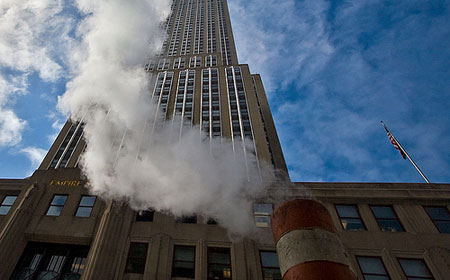
Photo (cc) broddi
The City Council took aim at the city's largest polluter Wednesday by requiring property owners audit energy usage and make maintenance overhauls to cut back on carbon emissions.
Council Speaker Christine Quinn said the package of legislation would set a standard nationwide. Buildings of more than 50,000 square feet will have to upgrade their lighting by 2025, and those same buildings will now have to conduct energy audits every 10 years.
The city's existing buildings account for 80 percent of the city's carbon footprint and represent $15 billion a year in energy costs.
While environmental advocates and city officials championed the green-buildings package, some critics question the effectiveness of one piece of legislation (Intro 967-A), which originally required large buildings adopt the recommendations of the now-required energy efficiency audits. The version the City Council approved yesterday by a vote of 41 to 5 would make those recommendations voluntary.
Greening Buildings
Some charge the council backed away from the tougher legislation because of lobbying from the city's business industry, which called the bill too expensive to implement in a floundering economy. Quinn argued yesterday that the council decided not to push for mandatory retrofitting because it would require a significant capital investment by landlords that would, in turn, trigger rent increases.
Even without the mandatory retrofitting, officials have acknowledged that the entire package of legislation could be costly for property owners. But they argue overall it is a net positive.
"Once these changes are put in place very quickly the building will not only make back whatever they have put in, they will actually begin to go beyond that and save," said Quinn.
While the council abandoned the requirement for retrofitting, officials did say the city would strive to set an example. The bill requires the city retrofit its buildings if audits show it would result in savings on energy bills in seven years.
The council is also requiring owners of large buildings to conduct smaller energy-efficiency improvements, which would have less of an impact on their pockets. Before every audit is submitted to the Buildings Department, buildings of more than 50,000 square feet will have to be retro-commissioned, which is when maintenance and low-cost performance improvements are made to increase a building's energy efficiency.
Overall, the entire legislative package, said Quinn, would reduce the city's carbon footprint by almost 5 percent. Quinn also said the bills would create 18,000 green jobs.
Environmental advocates have praised the package.
"You come into a negotiation asking for more than what you were going to get," said Dan Hendrick of the New York League of Conservation Voters. "Even with all the amendments, it's still groundbreaking."
In addition to the auditing bill, the council also passed legislation (Intro 973-A) by a vote of 44 to 2 that requires buildings of more than 50,000 square feet to make lighting upgrades by 2025, including the use of sensors and more efficient light fixtures. It would also require the installation of submeters, and landlords would have to provide tenants with monthly breakdowns of their electricity consumption.
In addition, the council unanimously approved a new energy code (Intro 564-A) that requires equipment installed during renovations to meet efficiency standards, and it approved legislation (Intro 476-A) that requires large and city-owned buildings to monitor their energy and water consumption and report it to the Department of Finance. That data will eventually be made public.
Fresh Foods
In addition to its green-buildings package, the council approved a zoning and financial incentive program to spur the construction of supermarkets in neighborhoods that have a drought of fresh food. Otherwise known as the Food Retail Expansion to Support Health, the program targets neighborhoods in the South Bronx, Upper Manhattan, Central Brooklyn and Downtown Jamaica.
Its incentives include: allowing one additional square foot of residential floor area for every square foot of a fresh food store up to 20,000 square feet, allowing grocery stores of 30,000 square feet and below to locate in light manufacturing areas, and reducing the parking requirements for grocery stores in this area.
Stated Meeting: Green Building Bills Approved by the Council

Photo (cc) broddi
The City Council took aim at the city's largest polluter Wednesday by requiring property owners audit energy usage and make maintenance overhauls to cut back on carbon emissions.
Council Speaker Christine Quinn said the package of legislation would set a standard nationwide. Buildings of more than 50,000 square feet will have to upgrade their lighting by 2025, and those same buildings will now have to conduct energy audits every 10 years.
The city's existing buildings account for 80 percent of the city's carbon footprint and represent $15 billion a year in energy costs.
While environmental advocates and city officials championed the green-buildings package, some critics question the effectiveness of one piece of legislation (Intro 967-A), which originally required large buildings adopt the recommendations of the now-required energy efficiency audits. The version the City Council approved yesterday by a vote of 41 to 5 would make those recommendations voluntary.
Greening Buildings
Some charge the council backed away from the tougher legislation because of lobbying from the city's business industry, which called the bill too expensive to implement in a floundering economy. Quinn argued yesterday that the council decided not to push for mandatory retrofitting because it would require a significant capital investment by landlords that would, in turn, trigger rent increases.
Even without the mandatory retrofitting, officials have acknowledged that the entire package of legislation could be costly for property owners. But they argue overall it is a net positive.
"Once these changes are put in place very quickly the building will not only make back whatever they have put in, they will actually begin to go beyond that and save," said Quinn.
While the council abandoned the requirement for retrofitting, officials did say the city would strive to set an example. The bill requires the city retrofit its buildings if audits show it would result in savings on energy bills in seven years.
The council is also requiring owners of large buildings to conduct smaller energy-efficiency improvements, which would have less of an impact on their pockets. Before every audit is submitted to the Buildings Department, buildings of more than 50,000 square feet will have to be retro-commissioned, which is when maintenance and low-cost performance improvements are made to increase a building's energy efficiency.
Overall, the entire legislative package, said Quinn, would reduce the city's carbon footprint by almost 5 percent. Quinn also said the bills would create 18,000 green jobs.
Environmental advocates have praised the package.
"You come into a negotiation asking for more than what you were going to get," said Dan Hendrick of the New York League of Conservation Voters. "Even with all the amendments, it's still groundbreaking."
In addition to the auditing bill, the council also passed legislation (Intro 973-A) by a vote of 44 to 2 that requires buildings of more than 50,000 square feet to make lighting upgrades by 2025, including the use of sensors and more efficient light fixtures. It would also require the installation of submeters, and landlords would have to provide tenants with monthly breakdowns of their electricity consumption.
In addition, the council unanimously approved a new energy code (Intro 564-A) that requires equipment installed during renovations to meet efficiency standards, and it approved legislation (Intro 476-A) that requires large and city-owned buildings to monitor their energy and water consumption and report it to the Department of Finance. That data will eventually be made public.
Fresh Foods
In addition to its green-buildings package, the council approved a zoning and financial incentive program to spur the construction of supermarkets in neighborhoods that have a drought of fresh food. Otherwise known as the Food Retail Expansion to Support Health, the program targets neighborhoods in the South Bronx, Upper Manhattan, Central Brooklyn and Downtown Jamaica.
Its incentives include: allowing one additional square foot of residential floor area for every square foot of a fresh food store up to 20,000 square feet, allowing grocery stores of 30,000 square feet and below to locate in light manufacturing areas, and reducing the parking requirements for grocery stores in this area.
Moving the City Along the Road to Sustainability
On Earth Day 2007, Mayor Michael Bloomberg announced PlaNYC 2030 -- a long-term vision for environmental sustainability for New York City. Unlike many other vision documents that are long on rhetoric and short on details, PlaNYC included more than 100 quantifiable strategies to hold Bloomberg and future administrations accountable on a wide range of environmental, economic and quality of life metrics.
By combining long-term vision with short-term quantifiable goals, PlaNYC 2030 changed the environmental debate in the city. PlaNYC represented a major new undertaking for the Bloomberg administration, which had focused on other issues during its first term. PlaNYC reframed the environment as a major priority for the mayor. It cast environmental sustainability as a critical component of how Bloomberg and his successors will meet the needs of an estimated one million additional New Yorkers who are projected to live in the city by 2030.
As an initial step, a new Office of Long-Term Planning and Sustainability was created to oversee the implementation of PlaNYC 2030. This office has been releasing implementation reports that provide a good overview of the mayor’s record on these issues so far. They and other materials are available here.
The mayor’s record on three key environmental issues is summarized below.
Air Quality
Given the millions of people who live, work, drive, use electricity and make things here, plus the tons of pollution that blow into New York City from upwind power plants in other states, air pollution is an unfortunate byproduct of life in the city. In fact, our city has never met -- and still does not meet -- the federal health standards for particulate matter (soot) or ozone (smog). In addition, thanks to the siting of commercial truck routes and bus depots, historically under-enforced anti-idling laws, and old boilers burning extremely dirty heating oil in many buildings, residents of low-income communities and communities of color breathe especially high levels of pollution.
In PlaNYC 2030, the Bloomberg administration vowed to "achieve the cleanest air quality of any big city in America." Recognizing the need to reduce community-level exposure to air pollution, PlaNYC2030 took aim at the high pollution exposures experienced throughout Hunts Point, Harlem and other low-income communities and communities of color. This approach was a logical follow-up to the focus on addressing inequities in the siting of waste facilities in the Solid Waste Management Plan, adoptedin 2006.
Some of the highlights of the mayor’s record on air quality include:
- To protect the city’s school children, Bloomberg worked with the City Council to create legislation, signed earlier this month, to retire old school buses and require filters to reduce the amount of pollution inside school buses, following similar new laws to reduce emissions from construction equipment, transit buses and other diesel engines used for city business that he signed in 2003, 2005 and 2007.
- To reduce pollution and increase efficiency in the city’s highest mileage vehicles, the mayor worked with Councilman David Yassky and others to craft legislation to convert the city’s yellow taxis to clean and efficient hybrid-electric models. When litigation stopped the implementation of the mayor’s original taxi program, he created a set of incentives that has led to a significant increase in the number of hybrid taxis -- today, 21 percent of the city’s yellow taxis are hybrids.
- To reduce emissions in neighborhoods plagued by heavy truck traffic, the city partnered with the state Department of Environmental Conservation to create better enforcement of anti-idling laws along heavy truck routes, especially in environmental justice communities.
- To reduce pollution from critical -- but highly polluting boats -- the Staten Island Ferry and several private ferries are using cleaner fuels and advanced pollution control systems, eliminating more than 300 tons of smog-forming gases every year.
- To reduce emissions around schools, the Department of Education has installed new boilers to replace extremely old and dirty boilers in several dozen schools.
Climate Change
Probably no issue evokes the old slogan, "Think Globally, Act Locally" more than climate change. The impacts of climate change—including hotter temperatures, rising sea levels and increased precipitation—are as much a local issue for New York City as they are a global issue for the nation and the world.
In PlaNYC2030, the Bloomberg administration aims to reduce global warming emissions by more than 30 percent by 2030 (last year, these emissions dropped by 3.5 percent in the city). By that time, the city projects that 85 percent of our energy consumption will come from buildings that already exist today. Thus, the administration has focused on investments that will make our existing buildings more energy-efficient.
The list of climate initiatives contains large items and small, as the following list shows:
- The city has been investing approximately $80 million per year to make existing government buildings more energy-efficient -- and has launched more than 224 energy efficiency projects on government buildings.
- The city Energy Planning Board was launched to coordinate planning among a wide range of city and state agencies to meet the city’s energy supply and demand needs.
- Bloomberg and former Vice President Al Gore launched an NYC Service initiative to organize volunteers to coat rooftops with reflective coating to reduce cooling costs and greenhouse gas emissions.
- The city committed to investing $25 million in energy efficiency improvements in the Castle Hill Houses in the Bronx.
- The Departments of Transportation and Parks and Recreation are collaborating on a pilot program to test high-efficiency, LED lights in parks and on roadways. Right now, the lights are easiest seen in Central Park from East 67th to East 72nd Street, but the city plans to expand the program.
Plus, many of the air quality and transportation initiatives will contribute to the climate goals. For example, those hybrid-electric taxis will cut fuel costs and climate pollution from the city’s highest mileage vehicles -- and all of the new bike lanes will help New Yorkers leave their cars at home, cutting congestion and climate pollution even more.
Transportation
In 2008, the mayor’s proposal to use congestion pricing to fight traffic and help fund the Metropolitan Transportation Authority dominated the transportation agenda of the city and state. When the plan hit a roadblock in Albany (after passing the City Council), attention turned to efforts that could improve transportation in the city without requiring the state legislature's approval.
Today, New Yorkers are resting in pedestrian plazas formerly reserved for honking cars and riding to work on dozens of new bike lanes. Work is progressing on "Select Bus Service," a new style of bus service that is providing a faster, more convenient bus commute along Fordham Road in the Bronx and that is slated to be expanded throughout the City over the course of the coming decade. Perhaps most important, the city’s Department of Transportation is being revitalized and reshaped by Commissioner Janette Sadik-Khan from its traditional focus on moving cars into an agency of multi-modal mobility advocates.
Here are some highlights:
- NYC Transit and the city are implementing a plan to convert five bus corridors to Select Bus Service by 2014 (besides the existing Fordham Road line, Nostrand Avenue, First and Second Avenues, Hylan Boulevard and 34th Streetare all slated for Select Bus Service). Select Bus Service is the New York version of the Bus Rapid Transit systems being developed throughout Latin America and Asia. These systems offer many attributes of subways (e.g., paying before you board, longer distances between stops), yet are faster and less expensive to implement because they operate on the roads. The expansion of Select Bus Service is a tribute to the success of the first pilot project on Fordham Road in the Bronx -- which reduced travel times by 19 percent while carrying 5,000 more riders per day. The city and NYC Transit are discussing a second phase of projects that will identify another eight to ten corridors for Select Bus Service by 2020.
- More than 200 miles of bike lanes have been installed in all five boroughs in the last three years. This has almost doubled the number of bike lane miles in the city, and has raised the visibility and safety of bikers. Add in a new bill to allow bike commuters to bring their bikes into their workplaces upon a tenant’s request, another bill to require large parking facilities to offer spaces to bicycles, more than 6,100 bike racks, 20 sheltered bike parking structures, and the result is a city that is becoming more bike-friendly every day. As a result, more and more people are biking to work and school -- the Department of Transportation estimates that bike commuting has grown 45 percent since 2006.
- More on the fun side of transportation: Green Light for Midtown, otherwise known as "closing Broadway to cars" is revising the way New Yorkers look at our streetscapes. In particular, the pedestrian plazas in Herald Square and Times Square have become de rigueur stops for midtown workers, residents and visitors at lunchtime, after work and late into the night. And car-free days on Manhattan’s Park and Fourth Avenues have created new energy and vibrancy along these promenades on many otherwise-sleepy summer weekends.
After two and a half years, the progress on PlaNYC’s key air pollution, transportation, and climate change initiatives is clear. On other critical environmental issues, the path toward greater sustainability in the coming decade has been laid out: More than 250,000 trees have been planted with a goal of one million new trees, an Office of Environmental Remediation has been created to clean up brownfields that don’t qualify as federal Superfund sites, plans to clean up pollution from dirty home heating oil are being developed, and a package of bills to require that large buildings improve their energy efficiency awaits action by the City Council. While there is still work to be done, the city has embarked on a strong path toward a more sustainable future.
Rich Kassel is a longtime environmental advocate on air, energy and transportation issues in New York City.
Switch It On!
In the last few days, we have seen Climate Week come and go, Mayor Michael Bloomberg tout painting city roofs white and California propose to cut the electricity consumption of your plasma TV by a third.
Energy efficiency is on everyone's mind, including ours.
That's why we have turned a spotlight on New York City's electricity future with Switch -- the final game in our series funded by the John S. and James L. Knight Foundation. A matching game similar to Concentration or Memory, Switch lets you solve New York City's energy crisis.
Between 2005 and 2030, the city will have to come up with about 22 million additional megawatt hours annually to meet our growing electricity demand, according to the Bloomberg administration's sustainability plan, PlaNYC 2030.
In Switch, we ask you how the city should do it. Turn out the lights? Build an offshore wind farm? What about nuclear power?
Switch gives you scores of options. Play again and again and see what conservation policies or generation proposals can close our electricity gap.
And for a sneak peek of the proposals included in Switch see our glossary below.
GENERATION OPTIONS
Solar Panels for City Buildings
Picture City Hall decked out in solar panels. It could happen. According to a 2006 study by the City University of New York, the city gets hit with twice the amount of solar energy we need to run it. But solar can cost more than four times as much as other renewable options. Despite that, the city has started to harness the sun, with 65 percent of solar energy in the city coming from panels on public buildings, according to CUNY.
Solar Powered Apartments
New York may not seem sunny, but solar panels on every inch of residential rooftop that could host them would create more than twice the amount of electricity we need to meet the demand of 2030. But property owners might balk at installation costs -- $4 a watt by some estimates. In response, the state offers financial incentives that could cover 40 to 70 percent of the installation costs. More recently, a City Council member has proposed solar zones to encourage neighbors to join together to share the expense.
Wind on Fresh Kills
From garbage dump to wind farm? Borough President James Molinaro wants to put seven 400-foot wind turbines on Staten Island's Fresh Kills, the landfill turned park. The turbines could produce enough electricity to power 5,000 homes. That kind of small-scale wind farm, according to Columbia University, could cost around $40 million, but the borough president's office says it would get private financing. Despite that, so far, the proposal hasn't picked up any gusts.
Tidal in the Hudson
Tidal power scoffs in the face of cloudy afternoons and breezeless mornings. But it has lagged behind wind and solar power in popularity, making it more expensive. And there are fewer government incentives to boost its use. A 10-megawatt project, one company estimates, could cost $2,000 per kilowatt to install. Some worry that the underwater energy, which has the most potential in the mighty Hudson, will hurt wildlife or interfere with marine navigation.
Tidal in the East River
Some of our electricity already comes from the depths of the East River. A local company has launched a pilot tidal turbine program there, which could bring as many as 30 turbines to the estuary's floor. Its results could determine the potential for tidal turbines elsewhere in the city. For now, it's an expensive technology (about $4,000 per kilowatt for installation alone), and some fear it could disrupt marine navigation and wildlife.
Nuclear Power Plant
No one wants to contemplate a Three Mile Island in a city of 8 million, so New York City probably will never see a nuclear plant within its borders. But it isn't as though we don't use nuclear energy. About 20 percent of our electricity comes from the Indian Point plant -- about 35 miles away. If we built a nuclear power plant in the city, it could cover almost all of our energy gap. Nuclear power does not emit carbon. What to do with the waste, though, is a whole different story.
Geothermal in Institutional Buildings
Geothermal energy uses the earth's constant natural temperature to heat and cool buildings. Heat pumps buried deep in the ground use the earth's temperature -- which averages 50 degrees underneath New York State -- to supplement a building's heating and cooling systems. During the cold months, the pumps pull warmth from the ground and circulate it through the building. It does the reverse -- drawing heat from the building underground -- in warm months. Geothermal systems typically pay for themselves within 10 years, experts say.
Offshore Wind Farm
They have spawned bitter opposition in other areas of the country, but offshore wind farms can produce lots of energy. A wind farm 13 miles off Rockaway Peninsula with more than 100 turbines, each 400 feet high, could eventually create 700 megawatts of electricity, according to Con Ed, which is considering such a proposal. A project of that size, which would surely attract opposition for marring the beauty of the shoreline, could cost about $2.5 billion.
Turbines on Residential Buildings
The rooftops of small apartment buildings and brownstone backyards can play host to wind turbines. According to Columbia University, 13,000 apartment buildings in southern Brooklyn, Queens and Staten Island could each hold a 1-kilowatt system. But per kilowatt hour, these smaller projects can cost double to triple the amount of larger ones, and getting all the permits can discourage the most avid renewable energy advocate. To try to help, the state offers some financial incentives and tax breaks. An owner can expect the payback period to be seven to eight years.
Tower Turbines
Picture the New York Times building with a wind turbine spinning on top. The Bloomberg administration briefly floated the idea of turbines on skyscrapers, but the proposal has since been gone with the wind. It could resurface -- once supporters find a way to address fears that blades could spiral down from the sky, creating catastrophe. Even then, skeptics are likely to balk at altering New York City's classic skyline, considering wind's so-called skyrocketing cost.
Clean Coal
The holy grail of the energy industry, clean coal got a lot of buzz during the 2008 presidential race, but many experts contend that it doesn't exist. Nonetheless, a 40-megawatt, approximately $2 billion proposal for New York State does. The proposal, which we based our estimate on, aims to make coal clean by capturing carbon from a coal plant and trapping it underground.
Build Power Plants
If you need more energy, just make more. The city can always turn to Con Edison to create more power plants -- typically around 500 megawatts a pop. Each would cost about $1 billion to build. But assuming it burned natural gas, a new plant would have lower operating costs than greener technologies. To fill our energy gap, we need about six more. Good luck finding a community that wants one. Queens residents say they have enough.
Methane from Fresh Kills
Fresh Kills may have been Staten Islanders' nemesis for decades, but residents can now use the former landfill's noxious fumes to power their homes. The Department of Sanitation sells off millions of cubic feet of methane it extracts from the landfill to the local natural gas utility, which converts it to energy. The cost is on par with other power generated by natural gas.
Fuel Cells
Eight fuel cells are already run by the New York Power Authority in the Bronx, Brooklyn and Staten Island. Those cells use waste gas extracted from wastewater treatment plants and covert it into electricity. A fuel cell that generates 1.6 million kilowatt hours annually creates less than one percent of the emissions of a coal power plant. They are typically implemented on a small scale, however, so fuel cells alone can't solve our energy crisis.
CHP Systems
CHP systems combine the generation of heat and power into one system. Otherwise known as cogeneration systems, they increase efficiency by capturing the heat that would usually be rejected by our normal electric systems. For instance, heat that was created but not used by your steamy shower could go into the building's electric system instead of being wasted. In the mayor's PlaNYC 2030, the administration envisioned creating at least 800 megawatts with this technology by 2030. Per kilowatt, it costs about $1,200 to install. Per kilowatt-hour, it costs about 6 cents to operate.
Energy Generating Floor in Subway Stations
Tested in Tokyo train stations, an energy-generating floor harvests kinetic energy from the soles of weary commuters' shoes to create electricity. Sure, it's expensive (and you can bet that the cash-strapped Metropolitan Transportation Authority won't buy into it anytime soon), but the technology exists. Our estimate anticipates a five-foot pathway in all of the city's 468 stations.
Energy-Generating Doors in Restaurants
Swish through a revolving door and create energy. That's what they do in some places in the Netherlands. Still in its pilot stages so capital costs are hazy, energy revolving doors are said to cut down on overall energy operating costs. Given the technology is in its infant stage, we aren't sure by how much.
Repower Plants
Instead of building new power plants, we can spruce up the ones we have to increase capacity and reduce emissions by as much as 80 percent. NRG Energy wants to "repower" a plant in Astoria but it requires a significant financial investment. Repowering can cost more than $1 billion.
CONSERVATION
Ban Air Conditioning in Commercial Buildings
Sure, it will be hot, but imagine the savings! About 17 percent of electricity in office buildings goes to air conditioning. If we banned it, we would be 10 percent of the way to closing our energy gap. Watch out for protests from sweaty office workers.
Greener Building Code
Requiring new construction and existing buildings to consider energy efficiency in their designs could get us almost a third of the way to closing our energy gap. The new code would include rebates for green buildings, require white roofs and stronger ventilation. According to some estimates, greener construction could increase the cost of projects by 3.5 percent.
Air Conditioning with the Door Shut
The City Council has already done it, much to the chagrin of some retailers. Commercial establishments can no longer open their doors and crank up the AC to lure customers inside on sweltering days. By some estimates, stores that leave their doors open with the air blasting can use 25 percent more electricity than those that let the cooling go on only behind closed doors.
Eradicate Phantom Loads
It looks benign, but that cell phone charger or cable box plugged into the wall uses the same amount of energy when it's off as when it's hard at work charging your phone or illuminating NY1. Simply turning these things off can cut our electricity use by 5 percent.
Tinted Energy Efficient Windows
If you thought tinted windows went out with the 1980s, you thought wrong. Putting some tint on sealed windows can keep out sunlight and reduce air conditioning costs by up to 75 percent. Such a renovation has upfront costs, but experts say it ends up paying for itself.
Dark Skyline
New York's skyline, lit up even after most of us are sound asleep, is an urban icon -- and an electricity guzzler. Lighting accounts for approximately 22.5 percent of the city's energy use. If New Yorkers everywhere, from your own apartment to City Hall, had to turn the lights out from, say, 11 p.m. to 7 a.m., it would cut the amount of electricity and money that goes for lighting by about a third. Watch out, though, for what might be lurking in the dark.
Lights Out at Institutional and City Buildings
Most likely, your regular city workers aren't pulling all nighters. Requiring all city and institutional buildings to turn out the lights at night could help close the electricity gap. The Bloomberg administration has endorsed the proposal, but has been known to keep the bulbs burning long after the witching hour.
LED Street Lamps
No one wants to leave city streets pitch black. So some support LED, or light emitting diode, street lamps, which shine on sidewalks, but let the city reduce its own electric bill by 20 to 30 percent. Though the new lights initially would cost $47 million, officials estimate the energy savings would cover that expense in less than four years.
Upgrades for Commercial Buildings
Owners of commercial buildings could help close the energy gap, city officials say, if they examined their own energy use and worked to reduce it. Improvements could be mandatory in vacant space or buildings slated for renovation. These retrofits and lighting improvements could come with upfront costs, but in the long run, supporters argue, this PlaNYC 2030 goal ends up paying them back. Of course, this may be a tough argument to make with commercial real estate mired in a deep slump.
Energy Smart Fridges
A new energy smart refrigerator can keep lettuce crisp and beer frosty with half the electricity used by older models. But if the city required it, it could cost landlords more than $1.5 billion. There are tax incentives and rebates available for the purchase of energy efficient refrigerators.
Green Roofs on City Buildings
Planting vegetables, trees or shrubs on a city roof can reduce electricity use in the building by up to 15 percent. Plus it looks nice, catches stormwater runoff and might even produce some fresh heirloom tomatoes. But it may cost $8 to $10 more per square foot than a conventional roof.
Incentives for Energy Efficient Appliances
The city says it would work with distributors and local retailers to create incentives for residents to buy high efficiency products, like washers and dryers, electronics and air conditioners. Officials could give about $100 financial incentive for residents and landlords to buy the more expensive, but energy efficient products.
CFL Voluntary Replacement Program
Unscrew that old-fashioned light bulb. The mayor's PlaNYC 2030 wants to see 180,000 apartments a year trade in their old, incandescent light bulbs for new, more energy efficient bulbs at no cost to the resident. In the long run, the administration argues the program is cost neutral, because the bulbs save so many megawatt hours.
Ban Standard Light Bulbs in Homes
A compact fluorescent bulb, while more expensive to buy, can use 75 percent less energy than a regular incandescent bulb. Because compact fluorescents last longer, the Department of Energy says you can save up to $107 and 12 light bulb changes for every one you use.
Smart Cable Boxes
Cable boxes can consume large amounts of energy -- even for those of us who are not couch potatoes and rarely turn them on. Requiring cable boxes with smart technology, which would automatically go on sleep when not in use, could cut our cable box consumption by half. By some estimates, that's like taking 2.5 million vehicles off the road.
Daylighting in City Buildings
Call it mood lighting. Better known as daylighting, this technology responds to the amount of sunlight shining through the window. So if it's extra bright, the lights will barely be on. If it's dark, they will be full blast. This technology can cut lighting megawatt hours by 26 percent.
Motion Censored Lighting in City Buildings
Lighting can be just like your shadow; it follows you wherever you go. Using motion-censored lighting can decrease lighting use more than 12 percent. Think about all those megawatt hours you can put toward something else.
Reducing Electricity in City Buildings
Turning out the lights, better maintenance, energy audits -- all of these can turn up a building's energy efficiency and turn down its megawatt hours. The city hopes to reduce its consumption by 30 percent by 2017. These upgrades could cost about $400,000 per public school, but the payback only takes seven to eights years.
Eight Candidates Run in a District Marked by Change
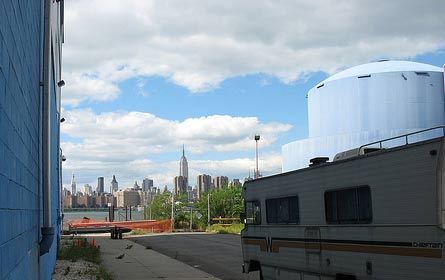
Photo (cc) jbeau
Greenpoint waterfront

If any single City Council district epitomizes the changes in New York over the last 10 years and the uncertainty of the economic future, it is District 33. Sweeping along the waterfront from Greenpoint to Carroll Gardens, and including northern Park Slope, District 33 has more than 65 percent white residents, the most affluent population in Brooklyn and one of the densest sets of active Democratic voters in the country. But it also includes some of the poorest residents.
Not surprisingly housing and development dominate debate in the crowded race to replace David Yassky, who is running for comptroller. Seven candidates are vying in the Democratic primary on Sept. 15, which will likely decide the winner of the Nov. 3 election. An eighth contender, Elizabeth Tretter, is waging a quiet campaign solely on the Conservative ticket. She has not appeared in any of the major debates hosted this summer.
The Democrats are a diverse crew, ranging from a recent college graduate backed by a party boss to a Lexus driving Hasidic Jew who dislikes bike lanes. Most observers view Jo Anne Simon, Stephen Levin and Evan Thies as the front-runners.

Jo Anne Simon
Simon, 56, a disability rights attorney, holds the post female Democratic district leader, an influential political stepping-stone. Her experience as a community leader converts into a solid voter following in the southern end of District 33, which is divided geographically by the Brooklyn Navy Yard. Thies, 29, is Yassky's former chief of staff and a public policy consultant.
Levin, is the recent college graduate backed by his former employer, State Assemblymember and machine party boss Vito Lopez. Levin, who often invokes Lopez's name, has picked up a list of high profile endorsements, including support from Sen. Charles Schumer and Rep. Carolyn Maloney.

Stephen Levin
Making the race tighter, the four other Democratic candidates aggressively frame important issues that the other candidates overlook. Kenneth Diamondstone, 60, the only openly gay candidate, campaigns on his record as a community advocate and affordable housing developer. Doug Biviano, 40, is an engineer and Brooklyn Heights building super and the newest face to politics. Isaac Abraham, 59, a hardware store owner and tenants' rights advocate, is the district's only Hasidic Jewish candidate. He has called for replacing bike lanes with parking spaces on the major bike commuter thoroughfare, Kent Avenue, and recently announced a plan to cut $1.2 billion from the city budget, the specifics of which he will unveil soon.
Ken Baer, an accountant, speaks mostly on environmental and quality of life issues, gained from his experience as the head of the local Sierra Club. Unintentionally entertaining audiences in debates, he often runs over time limits or misses his cue to speak.
A District Rezoned
The campaign is being waged in a district shaped by 14 rezonings since 2001. This is the highest concentration of rezonings to affect any council district, and they have quickly altered its physical and social landscape.
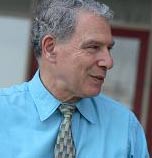
Kenneth Diamonstone
All seven Democratic candidates call for increased funding for community-based plans, also known as 197a plans, which the City Charter allows to accompany all rezonings. Simon, Abraham, Diamondstone and Thies all showcase their experience with these plans when discussing development in the district.
Simon advocated for open space and affordable housing in the Park Slope and Downtown Brooklyn rezonings, and lobbied against the Atlantic Yards project as chair and cofounder of the Boerum Hill Association. Building on what he learned in the 2005 rezoning of Greenpoint and Williamsburg, approved when he worked for Yassky, Thies campaigns for his “360 Degree Planning” proposal, which changes the city's land use review process to require input from major city agencies on how development might affect the whole array of municipal services. "We need to have all agencies weigh in on what we are planning for -- education, police, fire," he said.

Isaac Abraham
Diamondstone also targets the limits of the current planning process. "The role of city planning has been to make way for luxury housing -- and we don’t need more luxury housing," he said. "There has been no planning -- for schools, parks and infrastructure." He sees the Department of City Planning as "a real enemy of the people." Diamondstone is concerned that large developers too often outweigh the community when large-scale zoning changes take place.
Abraham, who helped develop the mixed income Schaefer Landing apartments on Williamsburg's waterfront, stresses the need for more affordable housing. Although he sports Dolce and Gabana glasses and glides down Kent Avenue in a Lexus SUV, Abraham is a well-versed tenant advocate in Williamsburg.
After the Boom
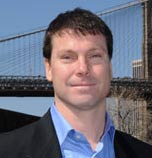
Doug Biviano
Of course the spate of luxury housing construction in the area may be over -- at least for now. Vacant, stalled, devalued or foreclosed luxury real estate now spots District 33 neighborhoods like the plague. Diamondstone, Biviano, Simon and Thies want the city to buy vacant or stalled new developments, and auction them off at more affordable rates.
Diamondstone, a lead developer on the affordable Schermerhorn House, argues that the city should offer tax abatements under the 421A program to developers anywhere in the city who designate 30 percent of all new homes as affordable -- 10 percent above the current level required.
Levin ran a tenant relocation program for Vito Lopez's Ridgewood Bushwick Senior Citizens Council that assisted residents while lead paint was removed from their apartments. Now, seemingly oblivious to the housing crash, he maintained that real estate prices in Brooklyn are still "still hot." He wants the government to require affordable housing, especially senior housing.

Evan Thies
With the economy in recession, Thies seeks to bring city-run incubators to aid freelance businesses into the district. In 2007, Thies helped repeal the Unincorporated Business Tax, a double tax held over freelancers making less than $100,000. He now favors repealing it for people making less than $150,000. On these issues, Thies has worked with the Freelancers Union, which has endorsed his candidacy.
Campaign Cash
The winner from Democratic Primary on Sept. 15 will likely win the council seat. Whatever Democrats emerges from that contest will then face Levin who can run on the Working Families ticket, regardless of how he fares in the Democratic primary, and Tretter on the Conservative ticket in November.
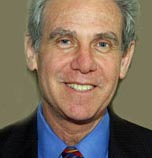
Ken Baer
In a Democratic Primary where 70,329 possible voters will have so many choices, the winner may result from a margin of fewer than 1,000 votes. So every campaign donation hints at that margin. As of this date, Simon has amassed the largest purse, at $103,383. Levin has raised a close second with, $90,738. Thies has brought in $64,399. Diamondstone totaled $51,424 with Abraham at $45,466. Baer has raised only $23,511 and Biviano has collected $20,830. Tretter is not listed with the New York City Campaign Finance Board.
This article was written under a partnership between Gotham Gazette and the Baruch College's Department of Journalism and Writing Professions.When first published, this story said candidate Isaac Abraham was 65 years old. He is in fact 59 years old. The story has been updated to reflect the correction.
Gowanus Canal Looms over District 39 Race

The swath of brownstone Brooklyn that makes up City Council District 39 includes some of the city's most gentrified neighborhoods. But much of the debate in the race to succeed City Councilmember Bill de Blasio revolves around what to do about a remnant of the area's far grittier past -- the notoriously noxious and toxic Gowanus Canal.
Five Democrats are vying for the party's nomination to replace de Blasio, who is vacating his seat to run for public advocate. Leading the pack in contributions and endorsements are Brad Lander, the director of the Pratt Center for Community Development; Josh Skaller, a leader of grassroots political and neighborhood organizations; and Bob Zuckerman, who runs environmental nonprofits. Rounding out the Democratic field are John Heyer, a licensed funeral director and special assistant to Brooklyn Borough President Marty Markowitz, and Gary Reilly, an attorney with a background in environmental and land use law.

Gary Reilly
Although the district is overwhelmingly Democratic, it features that rarest of all elections in New York City politics: a Republican primary. George Smith has the Conservative and Republican Party endorsements, but faces a challenge for the GOP line from corporate strategist Joe Nardiello, who likens himself to Teddy Roosevelt. David Pechefsky, the Green Party candidate, wants to break what he calls the Democrats' monopoly on power in the general election on Nov. 3. Libertarian Roger Sarrabo is also running.
The Big Issue
With so many candidates divvying up the electorate, the election could come down to a very few votes. On street corners, subway platforms and even in doorways, political hopefuls are scrapping for votes one handshake at a time. And one issue they hear about again and again is the Gowanus Canal.

Brad Lander
The Gowanus is a finger of pollution that pokes 1.8 miles through Park Slope and Carroll Gardens. More than a century of industrial dumping and combined sewer overflow has left the area filthy. Mayor Michael Bloomberg and the federal Environmental Protection Agency have opposing plans on how to go about a cleanup process that will take at least a decade to complete.
Bloomberg calls for spending $175 million in public funding largely to deal with the raw sewage that runs into the canal. But it remains unclear where the city would find an additional $200 million or more needed to clean up other contaminants.
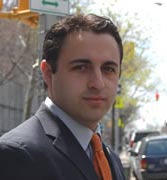
John Heyer
For its part, the Environmental Protection Agency's plan would designate the canal a Superfund site. That would require that private companies responsible for the pollution ante up for the cleanup. Critics of this solution say possible litigation could drag the cleanup process out for years.
While the Bloomberg administration opposes the Superfund idea, the Democratic candidates and Pechefsky generally agree that due to the expense and complex nature of the cleanup, only the Environmental Protection Agency has the expertise and authority to see the project through.
Bloomberg's most vocal critic on this issue is Skaller, who said, "I'm not sure what the mayor's plan is from week to week."
Reilly, Lander, and Heyer all express concerns that neither the mayor's plan nor the federal government's addresses the antiquated infrastructure that allows for combined sewer overflow, which means storm water and raw sewage enter the canal via the same drainage system after even moderate rains. Heyer does not believe the Environmental Protection Agency and mayor's plan are exclusive, and no matter which option is chosen, he wants the city to continue its plans to improve water circulation in the canal.

Josh Skaller
Smith worries that the mayor's plan relies too heavily on corporate money, even though the city calls for responsible corporations to pay for 35 percent of the cleanup, and Superfund designation calls for them to pay 100 percent. Nardiello is unimpressed by either solution because neither, he said, has a timeline or a strategy for addressing property values and air quality during cleanup.
As for what would follow any cleanup, most candidates envision a mix of business, industrial and residential use that conforms to the feel of the neighborhood and provides some public access to the waterfront. Smith, the owner of a party supply rental shop, proposes mostly affordable housing. As a small business owner, he believes too many new stores along the canal could hurt businesses that already exist on Court Street. Skaller, the former associate director of computer music at Harvard, mentions the possibility of an artist community.

Bob Zuckerman
Zuckerman, who is on leave from his position as director of the Gowanus Canal Community Development Corp. to campaign full time, pulls from his experience as director of the Gowanus Canal Conservancy when he suggests creating so-called "sponge parks" that would work as natural water filters. He also proposes establishing a green district in partnership with the nearby Polytechnic University that would feature alternative energy business, environmentally friendly construction and the like.
A Tough Battle
With eight men -- yes, all men -- competing for what amounted to 21,000 votes in 2005, candidates are pulling out all the stops as the primary nears.
Smith filed a suit challenging the validity of petition signatures of his Republican opponent, Nardiello, and Nardiello filed his own suit questioning Smith's residency in the district. The suits amounted to much ado about nothing, and both candidates are still in the race.
On the Democratic side, Lander is touting his status as the one candidate with children in public school, while noting Skaller's son attends private school. Skaller says the decision to send his son to private school is based on the child's special needs. Lander and Skaller have each charged the other with campaign finance irregularities.
On the endorsement front, Lander has the backing of U.S. Rep. Jerrold Nadler and of the Working Families Party, while State Assemblymember James Brennan supports Skaller. Heyer, the youngest candidate in the race, has secured the endorsements of State Assemblymember Joan Millman and the International Longshoremen's Association. Zuckerman won a late endorsement from Rep. Anthony Weiner. Gary Reilly has the personal endorsement of Maria Pagano, president of the Carroll Gardens Neighborhood Association.
In the race for funds, Lander and Skaller lead the way at $116,621 and $101,508 respectively. Zuckerman has reported $89,624 in contributions, while Heyer claims $64,825. Next is Reilly with $27,265 followed by Pechefsky with $14,129. Smith has tallied $2,265, and as of the last reporting date on Aug. 14, Nardiello showed no contributions.
Areas of Agreement
The intensity of the campaign might conceal the fact that on many issues most of the candidates agree. For example, on mayoral control of city schools, the candidates generally concur that anything is better than the old Board of Education, but they all are concerned with what they see as a lack of parent input in the current system. Only Nardiello approves of the current structure of the Department of Education.
The remaining seven candidates want to establish checks and balances, such as City Council approval of the chancellor, council appointments to the citywide Educational Policy Panel, fixed terms for board members and budgetary oversight. The most caustic words come from Reilly, who charges that school governance under Bloomberg has been "arbitrary" and "capricious."
Zuckerman said that whoever is chancellor should have an educational background, unlike current Schools Chancellor Joel Klein, who made his career in antitrust law.
All eight candidates decry the City Council's voting to extend the mayor's and their own term limits, overturning voters in two separate referendums. Only Nardiello believes, because of the recession, Bloomberg should run again. Pechefsky, Zuckerman, Heyer, Lander, Reilly and Skaller support a binding referendum on term limits.
All the candidates share the basic idea that any rezoning in the area should fit within the character of the community.
Everyone supports more affordable housing, although they differ on how to accomplish that. Nardiello wants to use eminent domain to seize stalled developments and focus on housing for seniors. Pechefsky calls for housing that would promote integration among income groups. Reilly wants stronger rent regulation. Heyer believes preference should be given to middle-income homebuyers and those already in the community, while Lander wants to give breaks to police officers, teachers and first-time homebuyers. Citing his history as director of both the Pratt Center for Community Development and the Fifth Avenue Committee, Lander also wants tax breaks and other incentives taken from builders who are sitting on stalled projects.
Zuckerman proposes the creation of community land trusts in which a non-profit organization would own a large piece of land and private residents would have individual homes on it. He also thinks developers should set aside 20 percent of homes in new developments for affordable housing. But Skaller, a volunteer organizer with Develop Don't Destroy Brooklyn is skeptical. "The City Council is bought and paid for by developers," and so, he said, with 80 percent of apartments being sold as luxury units, the median price for all homes rise.
This article was written under a partnership between Gotham Gazette and the Baruch College's Department of Journalism and Writing Professions.
Waiting to Wade
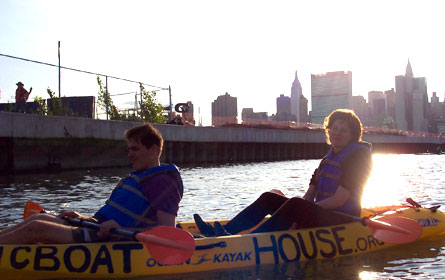
Photo by Courtney Gross
This story was done through a partnership between The Huffington Post's Eyes and Ears citizen journalism program and Gotham Gazette. Gotham Gazette reporter Courtney Gross wrote the piece using stories from New Yorkers gathered through The Huffington Post and Gotham Gazette. Sign up here to join Huffington Post's citizen journalism team covering New York to be part of more of these stories.
These were rough waters.
A group of 15 New Yorkers, including this reporter, set out on the East River Friday evening for a taste of the city’s sea salt. Two to a kayak, they trolled our marine superhighway, from the shores of Long Island City to the meandering, if slightly noxious, Newtown Creek, weaving between the city’s water taxis and bobbing in their wakes.
An activity once reserved for long weekends in the Catskills is now embarked upon here in the five boroughs –- life jackets included -– thanks to groups of aqua-friendly volunteers.
“I’m sorry I didn’t start coming out sooner,” said Ted Gruber, the de facto captain of one such group: the Long Island City Community Boathouse, which runs free kayaking programs every weekend. Gruber, a Greenpoint resident, has been paddling throughout the city’s tributaries and rivers for three years.
“Twenty years ago,” he added while pedaling his blue, foot-powered kayak in Newtown Creek, “it was unthinkable.”
Gotham Gazette on the Waterfront

.........................
National Parkland Not on Radar
Our parks columnist explores the national parkland along the New York Harbor -- an area most New Yorkers have never heard of.
.........................
The city has created a new plan for the ball fields on Randall's Island. Critics, though, are calling foul.
.........................
After three tries, a new Mass Transit Tunnel linking New Jersey and New York has broken ground. But advocates question whether this proposal will really ease traffic under the Hudson.
.........................
As planners and developers eye the water's edge, are grassroots and community advocates losing their say?
A lot of New Yorkers and many of you who responded to Gotham Gazette and Huffington Post’s inquiry on waterfront access say they also get their waterfront fix via vessel -- kayaking in Long Island City's Hallets Cove or paddle-boating under the Brooklyn Bridge.
Still, no one is ready to call the East River the new Grand Canal.
The Bloomberg administration’s pursuit of development along the city’s shorelines has brought a renewed focus to the waterfront. From preserving the working waterfront of Sunset Park to the construction of waterside parks in western Queens, points of access to the city’s 578 miles of water’s edge are popping up across the five boroughs. Though it may still be a long way from bringing the waterfront to every New Yorker, advocates say the city is no longer swimming upstream.
To tell us about your own waterfront activities or complaints, check out this map here.
Dipping a Toe In
Megan Browne, who lives in Dumbo at the mouth of the Brooklyn Bridge, takes her 5-year-old twins down to the water almost every day.
Browne, a 43-year-old California native who spent 16 years living abroad in Europe, said living by the waterfront is ideal -- even if New York’s waterfront recreational opportunities pale in comparison to other locations.
"In most European cities, I think they take much better advantage of the waterfront than New York does," said Browne. "It's always been a mystery to us."
But just 10 years ago, according to city officials and advocates, it was far worse. Up until the late 1980s, according to Department of Environmental Protection Deputy Commissioner for Wastewater Treatment Vincent Sapienza, more than 200 million gallons of sewage were discharged into the city's waterways every day -- a major impediment to waterfront recreation and development.
"Obviously, that made things pretty miserable," said Sapienza.
With the addition of new sewage treatment plants, Sapienza said the city is now capturing almost all of the city's wastewater during dry weather (during storms, it’s another story). The progress has allowed the state to designate almost all of the city’s waterways, including the East River, as boat and recreation friendly. The lower New York Bay, which includes the beaches of Staten Island and Coney Island, as well as parts of the Hudson River, from the Bronx to Westchester County, are deemed swimmable by the State Department of Environmental Conservation.
And as the water gets cleaner, more people are likely to jump in -- or at least paddle through, say advocates. President of the Metropolitan Waterfront Alliance Roland Lewis points out that a decade ago there were only two paddling organizations in the metropolitan area. Now there are 22, one of them being Gruber’s Long Island City-based kayakers.
As the East River lapped against the side of their yellow boats and salty water dripped from the tops of their paddles, the kayakers floated near Roosevelt Island, many wet from the waist down. Leslie McBeth, a Greenpoint resident that was joining for the first time, noted that the city’s newfound waterfront focus is even more evident from the water level. A shoreline once covered only with warehouses facing inland now has piers and large condominiums looking out on the water.
“It was kind of fun to see the city from a different perspective,” said McBeth. “There is so much water in New York… now people are facing it.”
The city, advocates say, is doing its part to encourage that. Last spring, the parks department launched the city’s first water trail –- a pathway made especially for kayaks, canoes and other marine recreation – connecting more than 160 miles of tributaries, creeks, rivers and bays.
Also within the past year, the City Council passed legislation requiring the city draft a waterfront plan every decade (the first is due out in December 2010); the city Planning Department revised its waterfront zoning rules, which it says will encourage more waterfront development and access; and the Bloomberg administration announced the expansion of ferry and water taxi terminals.
Much of this attention may be due to massive luxury residential development along the water. But whatever the impetus, advocates are cheering.
"I give them a very solid thumbs up on turning the corner," said Lewis. But, he added, "there is a long, long way to go."
Finding Your Way to the Edge
Gruber pedaled his way along Newtown Creek –- one of the city’s most polluted waterways –- as a putrid stench wafted overhead and beer cans floated by.
Lucky for this group, the rain had held off for a couple days. It could have been a much smellier story.
Thanks to the city’s combined sewer system, more than a tenth of an inch of rain can send millions of gallons of raw sewage spilling into our waterways. To avoid this, Sapienza said, the city is implementing a wide range of green (and clean) technologies, like porous pavement and green roofs that would trap the city’s stormwater or divert it from the system entirely. Two retention basins are already in use, holding millions of gallons of stormwater until it can gradually be released into the treatment system. Two more, one in Queens the other in Brooklyn, are scheduled to be in use next year.
The Department of Environmental Protection also sends boats out weekly during the warmer, recreation-friendly months to test contaminants in the water. (The boats go out monthly during the winter.) But unlike the city’s beaches, which have the health department sampling and notifying swimmers of water quality conditions , the city’s rivers and tributaries have no public notification system, and the health department does not sample them.
These conditions, says Lewis, prevent New Yorkers from utilizing the city’s waterways to their full potential.
“The limiting factor for a lot of recreation and enjoyment of the waterfront is the CSO [combined sewer overflow] issue,” said Lewis. “In this summer of rain it’s been particularly awful.”
Additionally, Lewis said, the less affluent areas of the five boroughs have a waterfront access drought. As an example, he noted that from Riverdale to the Bronx River, there is no launching point for the public to get onto the water.
Advocates want that to change. The more people use the waterway, said Lewis, the more the city will be required to accommodate them.
Back on the East River, the kayakers’ volunteer leader for the evening, Monica Schroeder, radioed to local marine traffic that the group would be paddling across the marine channel. A tugboat called back: “I’m eating kayakers tonight for dinner.”
Undeterred, the kayakers paddled on, claiming the East River for themselves.
Communities Drowned Out
Old tires. Invasive plants and rampant weeds. Mounds of garbage.
"Basically everything that ended up in the streets tended to end up in our riverway," said Miquela Craytor, executive director of Sustainable South Bronx.
Gotham Gazette on the Waterfront

.........................
Neglected National Parkland
Our parks columnist explores the national parkland along the New York Harbor -- an area most New Yorkers have never heard of.
.........................
The city has created a new plan for the ball fields on Randall's Island. Critics, though, are calling foul.
.........................
After three tries, a new Mass Transit Tunnel linking New Jersey and New York has broken ground. But advocates question whether this proposal will really ease traffic under the Hudson.
.........................
This is how she described the Bronx's Starlight Park -- a decrepit space, long-since abandoned by manufacturing companies who left behind remnants of contamination and debris.
This was, however, before her organization, and other local groups, intervened.
The revival of this park, and many others along the Bronx River waterfront, is thanks largely to Sustainable South Bronx, an environmental justice organization whose mission is sometimes stated as "greening the ghetto." Noting a lack of access to open spaces in their area, the organization's founder Majora Carter fought hard to secure a feasibility study for creating a greenway, which will eventually link restored parks up and down the Bronx River. To date, the project has secured nearly $30 million dollars, according to the group's Web site.
Today, Starlight Park is slated for a major renovation, which will include amenities such as ball fields, playgrounds, a floating dock and legitimate access to the visible – but often unreachable – Bronx River waterfront.
Sustainable South Bronx's activism has been admired nationwide, but community activism along New York City's coastlines is no longer a rarity, according to experts.
With a wave of development sweeping across the city's waterfronts, community-based groups are stepping up and making their voices heard -- initiating, advocating and constantly pushing for access in their neighborhoods. But even as the grassroots movement gains momentum, their priorities can sometimes get caught in a whirlpool of community, developer and city interest.
A Blue Movement
As the president and chief executive officer of the nonprofit Metropolitan Waterfront Alliance, Roland Lewis has seen the organization and power of grassroots groups along the city's shorelines.
"So many of these groups have taken it upon themselves to create access, use and participation in waterfront planning and development all across the city," said Lewis, whose organization is an umbrella of 400 local groups and agencies with ties to the New York and New Jersey coastline. "We sometimes call it a 'blue movement' and part of it is neighboring groups realizing that they have a stake."
Lewis said for most of New York's modern history, the waterfront "was cut off by industry, by roads, by rails. It became a place where no one wanted to be."
With many of these commercial enterprises leaving the coastlines, grassroots groups from Newtown Creek to the Hudson River are clamoring for their "stake" in the 578 miles of New York City waterfront -- 17 percent of the state's total coastline, according to the New York State Department of Coastal Resources.
The benefits to waterfront access are myriad for these communities -- a local economy stimulated by tourism and industry, the replacement of deteriorating brownfields, and the creation of recreation opportunities. The latter, said Lewis, is especially important for the outer boroughs, where the populations are traditionally underserved by open space.
"It's every person's right to be able to get to the water," said Lewis. "We can improve quality of life tremendously... especially for those of us who can't go out to the Hamptons."
Neighborhood and grassroots groups are in a unique position to push their agenda, according to Joan Byron, the director of Sustainability and Environmental Justice at the Pratt Center for Community Development. "There are things you can do from within government and you can only do from within government. But the power to advocate for specific projects is outside of government," said Byron. "Who else is going to do it?"
Organizations like Sustainable South Bronx, Friends of Brook Park and the Newtown Creek Alliance seem to be up to the challenge of trying to reconnect their constituents with one of the city's most valuable resources.
Community Voices Drowned Out
Judi Francis stands on a top level of a parking garage in Brooklyn Heights. She's facing toward the East River and the picturesque Manhattan skyline, but her gaze is downward at the proposed Brooklyn Bridge Park site.
The Brooklyn-Queens Expressway roars underneath, as Francis points out the future pedestrian entranceway to the park, now under-construction, which she deems hazardous.
"See, it will be very dangerous to cross there," she says. She shows me where her organization, the Brooklyn Bridge Park Defense Fund, a community-group opposed to current park plans, wanted to tunnel beneath the expressway to create a safer thoroughfare. "But we can't because where that strand of trees is, that will be a 20-story high-rise," says Francis, a resident of the area for 30 years and president of the defense fund.

Photo (c) BBPDC
An aerial view of the south portion of the Brooklyn Bridge Park. The contested high-rises are not in this artists' rendering.
That very high-rise, along with five others, has become a major point of contention between some area residents and the Brooklyn Bridge Park Development Corporation, a subsidiary of the Empire State Development Corporation, and a partnership of the state and the city. The governor and the mayor appoint their board. Francis charges that the city ignored years of community planning by local groups by erasing all recreational activities from park plans in favor of luxury condos, which the city says will help finance the project.
"One day I woke up like everybody in Brooklyn did, and I opened my New York Times, and a park that had been planned by the community all along the waterfront was suddenly transformed into a housing development with park-like elements," says Francis.
Francis, who says she speaks for 13 community associations and the local chapter of the Sierra Club, contends the condos have replaced a pool, skating rink and event venue, unofficially mapped by the neighborhood during 40 group sessions – making the future of the park a completely "passive" experience.
"You don't build a park with housing because the people who live inside the homes are not going to want people to tramp on their lawns," she said.
Francis isn't the only one disappointed in the plans. The Project for Public Spaces lists the Brooklyn Bridge Park in its design "Hall of Shame," along with other New York locales like Astor Place, Columbus Park Pavilion and the Federal Plaza.
"It's going to be beautiful but it will be limiting in terms of the amount of people and types of uses and flexibility to evolve over time," said Ethan Kent, vice president of Project for Public Spaces.
Kent said that waterfronts "are the face of the city" and should be designed to reflect the identity of an area. He said this was not the case for Brooklyn Bridge Park.
"Unfortunately it will be more of a suburban backyard or a Jamaica Bay, which again is beautiful, but not appropriate for the area," he said.
But Regina Myer, who heads the group charged with developing the site, the Brooklyn Bridge Park Development Corporation, said that she has received a tremendous amount of community support. This includes the likes of Brooklyn Bridge Park Conservancy and Community Boards 2 and 6.
"There were numerous community meetings that took place over the history of this project," said Myer. "It just so happens that the [Brooklyn Bridge Park] Defense Fund objects to our financial model."
Myer said these criticisms represent "one particular perspective" and that the housing complexes developed out of a plan to keep the park financed and maintained – with support from the neighborhood.
"The planning process really did evolve based on different community groups, financial constraints and physical constraints," said Myer. "I think people have recognized that there's no other source for maintenance and economic funds."
A Community Balance
The debate at Brooklyn Bridge Park points out the difficulties of balancing a community's vision with the feasibility of implementing and financing development.
"Waterfront planning projects around the world are undergoing this renaissance and shift in uses," said Kent. "So many of them are leading to conflict and frustration on the part of all parties."
Kent said under the current administration, community group's voices are often silenced.
"Unfortunately it has been something of a hallmark of the earlier years of the Bloomberg administration. A lot of the big projects sort of floundered and were led more by EDC [Economic Development Corporation]."
There are similar sentiments outside of Brooklyn. Back at the Sustainable South Bronx, Craytor said officials and developers occasionally labeled parts of their plans as "details," while they were high priorities to the community.
"Essentially our role was to say, 'No, this is what the community wants, this is what we were pushing for, so we have to find a different way,'" said Craytor. "If it wasn't for our presence in the room, I truly believe that certain elements would've disappeared."
Kent said that despite past planning, he feels positive about future development.
"We're still hopeful that with another term they might make community-based planning and public planning a real legacy of their administration," said Kent.
As Francis watches her dream park transform, however, she remains discouraged.
"It's the way the mayor has sort of transformed the city," Francis lamented. "Unless you're in a position of great wealth or great power, your voice means nothing."
Legal Ruling Puts a Cork on the Bottle Bill

Image adapted from EJP_Photo
On Monday environmental activists were supposed to be celebrating. The expansion of the state's bottle law was scheduled to go into effect, placing deposits on bottled water, increasing the handling fees stores and redemption centers get per can or bottle and directing 80 percent of unclaimed deposit money from bottling companies to the state. But that didn't happen.
On May 29 federal court judge Thomas Griesa issued an order preventing implementation of the entire law until April 1, 2010. Griesa's ruling came in response to a lawsuit brought by a group of bottled water companies that claimed the law was unconstitutional. The state can appeal the decision.
"Nobody could have predicted the judge's ruling. We were totally shocked," said Laura Haight, chief environmental associate of the New York Public Interest Research Group. The delay could now cost the state $115 million in unclaimed bottle deposits it was supposed to start collecting this year. And stores and redemption centers that were scheduled to see an increase in bottle-handling fees will lose that revenue.
Water bottling companies were upset that the law would have gone into effect just a month after it was signed by Gov. David Paterson, denying them, they said enough time to adequately prepare. "The amendment makes major changes to the bottle bill's framework and for the first time applies to bottled water producers and distributors, who have no experience with the law's provisions," read the complaint filed by the companies. "The short time frame for compliance with the bottle bill is arbitrary and irrational and thus violates plaintiff's substantive due process rights and unduly burdens interstate commerce in violation of the Commerce Clause."
After the bill passed, Haight said she realized the "timetable was very rapid," and expected legislators to address the concerns. They didn't. Haight said state leaders could not "agree on language."
The law also required all returnable bottles sold in the state to have New York State-specific codes. Companies said meeting such a requirement would be expensive, violate the Interstate Commerce Clause in the U.S. Constitution and would be hard to comply with on such short notice. Griesa ruled that this portion of the bill cannot be implemented or enforced at all.
The Fight for the Bigger Bottle Bill
Advocates have fought for years to have the law extended to include mandatory deposits on beverages other than soda and beer. They argue the expansion would increase recycling and reduce litter. Year after year, the Democrat-controlled Assembly would act on the legislation only to have Senate Republicans ignore it. But this year, with Democrats in control of both houses of the legislature, the fight was supposed to get easier. Again, it didn't.
Haight recalls that when she and like-minded advocates discovered that the bottle bill had been included in the budget agreement, they felt they had pulled victory from the jaws of defeat.
The bill, though does not go as far as they would have liked. For one thing, it adds deposits only to bottled water, leaving fruit juices, energy drinks and all the other soft drinks that have proliferated over the past 30 years out entirely.
Beverage companies ran television and radio ads against the expanded bottle bill across the state. They complained the expansion of deposits to drinks other than soda would drive up prices and hurt their business. According to NYPIRG, groups opposing the legislation gave over $2 million to state political parties and politicians in the last election cycle.
In the days leading up to the budget deadline, Haight said, she was just as unsure of what was included in the budget deal between the state's top Democratic leaders as everyone else. "We didn't know what was going on. We were in the dark like everyone else. We didn't know, and the legislators didn't know, either," she said.
Finally, when the three men in the room emerged to share the details, Haight was elated to find that bottle bill was part of the deal. But some legislators were not. According to Haight, "There was a lot of consternation among members of the Senate, as they had not been consulted [about the contents of the budget deal], and some senators went to work to try to unravel the deal."
Lobbyists representing the beverage industry walked the Capitol's halls complaining ferociously to legislators. Environmental groups started a pressure campaign of their own by having constituents call the office of Senate Majority Leader Malcolm Smith. "Our calls shut down his phone system," said Haight. "To this day don't know how we did it."
Those voicing concerns about the bill and its timetable also became more clamorous, though. Legislative leaders acknowledged the June deadline might be too much to ask of bottlers and indicated they were interested in taking action to give them some breathing room. The action did not materialize, though, and on May 18 the International Bottled Water Association, Nestle Waters North America and Polar Beverages filed a lawsuit challenging the bill's constitutionality.
Kennedy Weighs In
Another shocker for environmental groups occurred when environmental advocate Robert Kennedy came out against the bottle bill and signed an affidavit in support of the beverage companies' lawsuit. In an op-ed for the New York Times titled "A Bottle Bill That Will Rot Your Teeth," Kennedy attacked the bill as being "cooked up by lobbyists for makers of sugared drinks and their allies in the legislature." Kennedy wrote that the bill was absurd for adding deposits on bottled water but not sugared beverages like tea and sports drinks. Kennedy also said the bill would hurt municipal recycling efforts by removing water bottles from their programs.
Environmental advocates were enraged that Kennedy hadn't consulted them before taking his position public. They also noted that he runs a water-bottling company. Kennedy's Keeper Springs sells bottled water and donates its profits to environmental causes. "At first I just thought, 'He's got a water-bottling company,'" said Haight.
Haight said that the legislature did not include flavored beverages because grocery store owners complained that bottles that once contained sugary drinks would be messy and dirty their stores. She said that municipal recycling programs support the bottle bill. "Our coalition includes municipal recyclers who were pushing for this," she said.
No Redemption
It is not just the state that will lose money because implementation of the bill has been delayed. "This is going to impact every place where you return bottles," said Sheila Rivers, chairwoman of the Bottle and Can Redemption Association. "Corner stores, local markets and bodegas are all going to feel it. This will have a huge impact on New York City," she said.
Delaying implementation of the entire bottle law for a year will hurt stores and redemption centers, said Rivers, because the law was scheduled to increase the handling fee they receive, from two cents to three-and-a-half cents per bottle. That increase, Rivers said, is decades overdue. "We have no way to raise prices when costs go up," she said.
On top of that, she noted, redemption centers have been gearing up to deal with the influx of now redeemable water bottles. "Up until Friday we thought this was going to start," said Rivers. "I was in a store on Monday where they had big signs saying, 'We take water bottles starting June 1.' We had to plan for this." Rivers said many redemption centers will probably have to lay off staff they hired in anticipation of the increased workload. "A lot of redemption centers have closed this year, and a lot more will close if we have to try to hang on until next April," she said.
What's Next?
Representatives of water bottling companies say they would like to see all bottled beverages have deposits. "What we think needs to happen right now is for the bill to be fixed to include all bottles, and to make sure unclaimed deposit revenue is funneled back to the municipalities to support community-based recycling," Trish Wexler, spokeswoman for Nestle Waters North America told the Associated Press.
Advocates say it is ludicrous for bottled water companies to say they back expanded recycling when they sued to bring an end to the bottle bill.
For now, activists are waiting to see how Attorney General Andrew Cuomo reacts to the ruling to see how the state might go ahead in addressing concerns about the bill. "We will know what the attorney general's office will do in the coming weeks," said Haight, "but the question is, will the legislature do their part if they have a role to play? Right now it seems they are comfortable to sit back and let the governor take the blame, but we aren't willing to do that."


